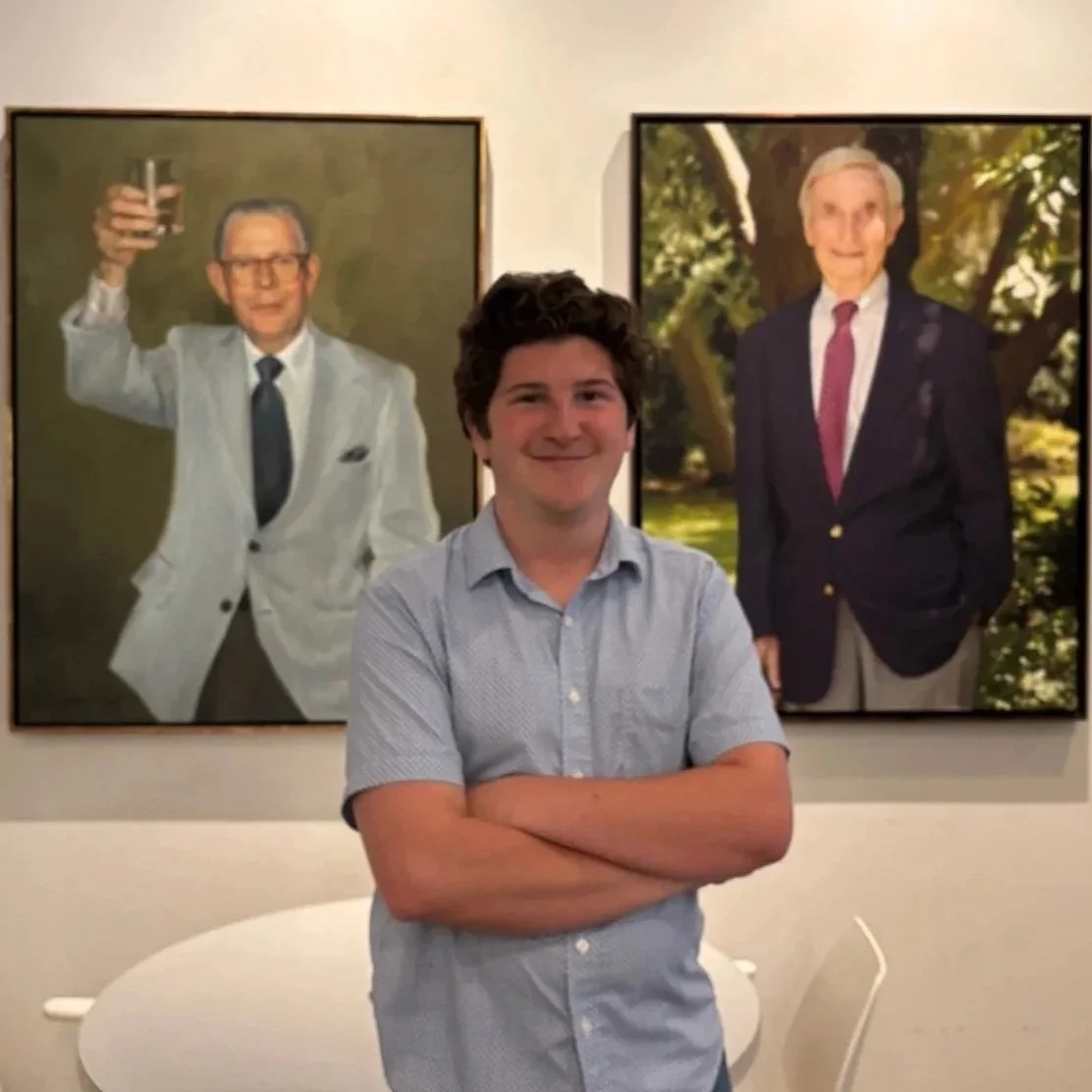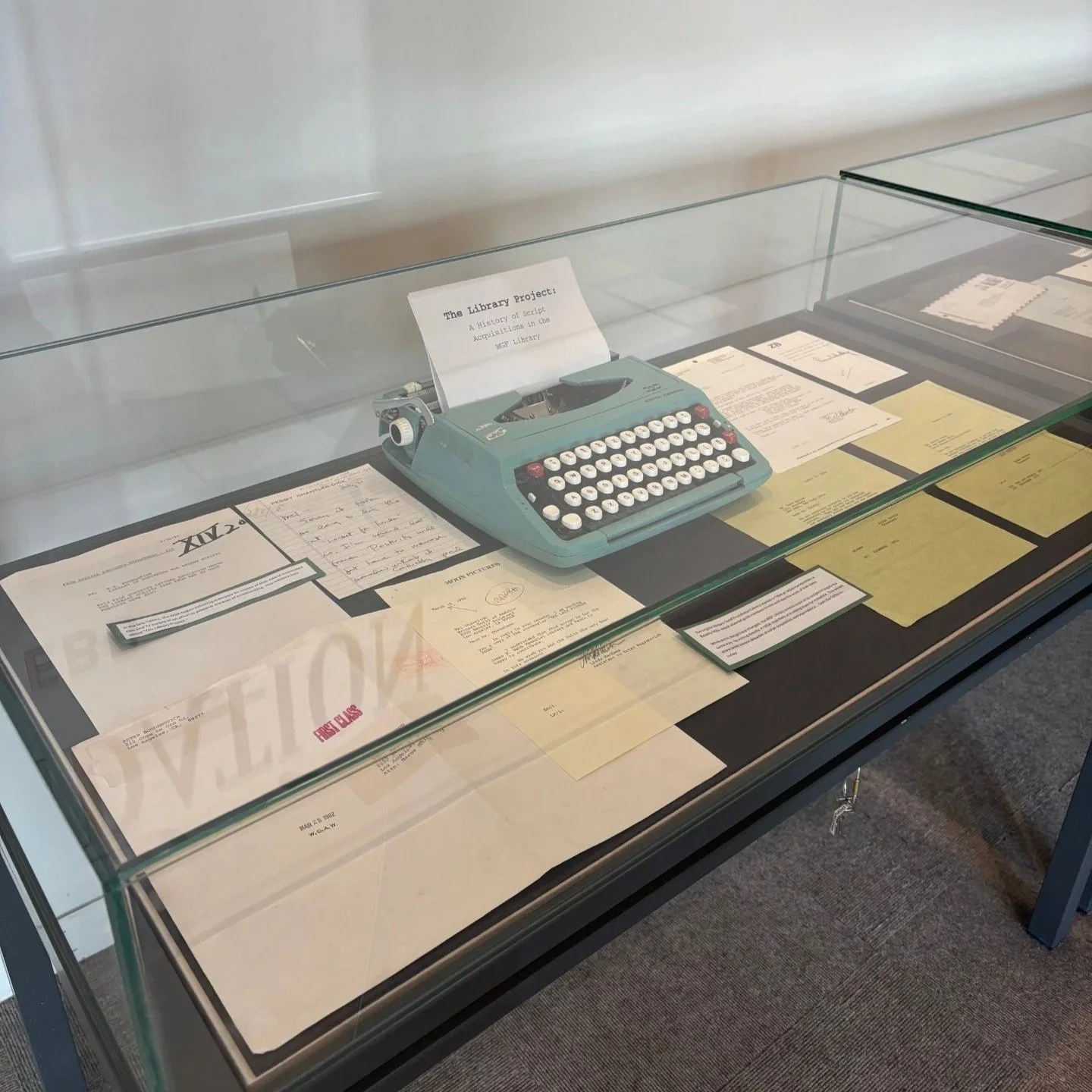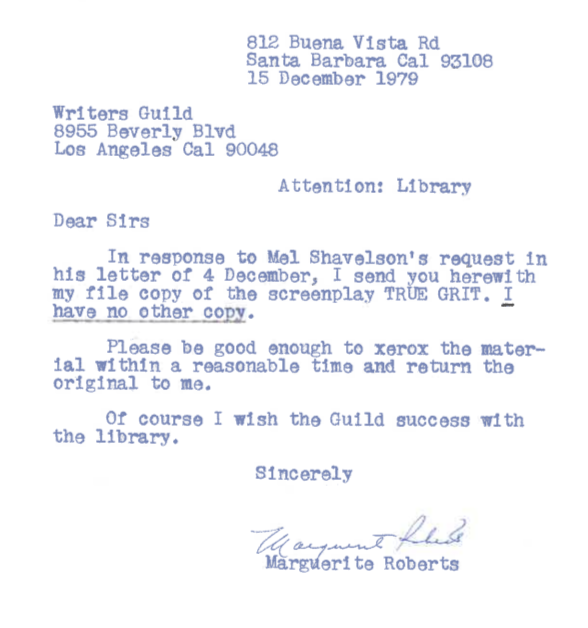The Library Project: A New Exhibit (And an Intern’s Journey Through 60 Years of Screenwriting History)
Hello! My name is Truman Lapp, and I’m a Summer 2025 intern here at the Writers Guild Foundation.
I’ve been tasked with a lot during my time as an intern here at the Shavelson-Webb library. I fulfill script requests for patrons, catalog newly acquired scripts into the database, and I sneak up to the second floor for coffee on occasion. After college, I hope to move back to Los Angeles to pursue a career in screenwriting. As such, working in an environment where I’m surrounded by so many fantastic scripts, talented writers, and knowledgeable people has been such a valuable experience for me.
Intern Truman Lapp stands in front of portraits of the two screenwriters for whom the library is named. James Webb (left) was the first President of the Writers Guild Foundation and original visionary behind the library. He passed away in 1974 before it came to occupy a real space in 1984. Mel Shavelson (right) was the second President of the WGF and a tireless advocate for the library and the WGF.
The project I've focused on most during my time at the WGF has been a new exhibit called The Library Project.
A lot of people assume that the Writers Guild Foundation has access to any script (released and otherwise) at the drop of a hat. In actuality, this is not the case. For every script we have here at the library, we depend upon the time and generosity of writers, script coordinators, and countless others within the industry.
Work on building the library as we know it today began in the late 1960s, before a site for the library had even been secured. However, writers within the Guild saw the value of preserving the craft and gladly sent over their award-winning scripts to be added to the collection.
Much of the early correspondence between WGF librarians and writers (late 1960s - early 1970s) is recorded in the form of letters typed on flimsy, decades-old carbon paper. Many of these letters were filed away, Ark of the Covenant style, in the archive. During my first few weeks as a WGF intern, one of my tasks was sorting through these papers, marking notable correspondences, and removing any stray staples that may have been left over from when they were filed. (I’m now very, very adept at removing staples. I believe I could remove staples at a professional level should that ever become a viable career path.) As I looked through this correspondence from the start of the library’s history, it was amazing to read letters that proved to be the foundation upon which the library is built today.
Opening exhibit case for The Library Project: A History of Script Acquisition in the WGF Library.
Looking through these artifacts really makes you realize just how much of what the library offers depends upon the contributions of the writers kind enough to send their work.
Many notable letters (including correspondence with Nora Ephron, Paddy Chayefsky, Carol Serling, Lawrence Kasdan and Cameron Crowe) are now able to be viewed in the exhibit on display outside the entrance to the library.
Marguerite Roberts was a highly paid and in-demand screenwriter during the 1930s, 1940s and 1950s before being blacklisted and out of work for years. True Grit, released in 1969, earned Roberts a WGA Award nomination (for adapting the novel by Charles Portis) and much gratitude from John Wayne, who won his only Oscar for his role as Rooster Cogburn, and told her it was the best script he had ever read.
As the library’s collection grew and found a permanent home, the WGF made two important changes to their operation. 1) They expanded the criteria of their collection not to just award-winning scripts, but all produced scripts for TV and film. 2) They opened the library to the general public, not just to Writers Guild members. With these changes, the library became a resource not just for established writers in the industry, but also for burgeoning writers trying to get their start and looking for inspiration from their favorite scripts and writers.
During my time working in the library, I’ve really come to appreciate the library and its importance to the writing community, for emerging and seasoned writers alike. I think that it will always be important to preserve these scripts in some form, and I find it pretty admirable that an organization like the WGF has taken on the responsibility of making their vast collection available to people of all walks of life.
Today, the script acquisition process here at the library looks largely the same, albeit with the aid of email and other forms of digital conversation. As such, the final display case of the exhibit hosts printouts of emails sent to notable writers asking for scripts, and their respective digital responses.
Exhibit case for the Library Project, with script acquisition letters from the 1990s.
Also included in the exhibit's final case is a QR code which takes you to the library’s script wishlist, which hosts a litany of notable TV pilots and feature scripts that the library doesn’t have yet and wants for its collection. Please check out the wishlist here. Maybe you can help us find a script we’ve been looking for!
I hope you’ve enjoyed this trip through the library’s history as well as the written exploits of my time here as an intern. If you’d like to see this information written in a much more concise and well-informed manner, stop by the exhibit just outside the library and take a look. And as always, please make a reservation and come to the library (it’s free and really cool)!
Thanks for reading!
Truman Lapp, Summer 2025 Intern




